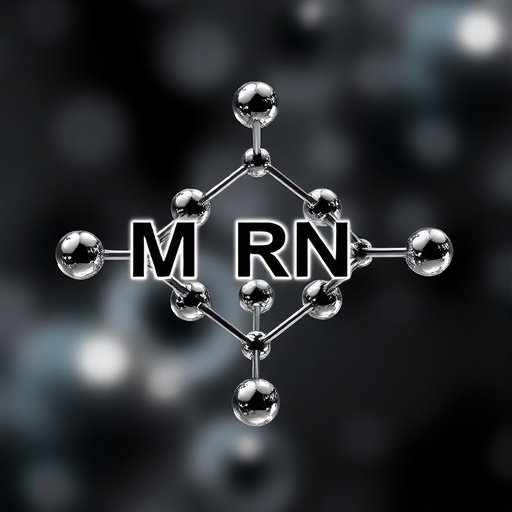A groundbreaking study recently published in the National Science Review unveils a transformative approach to controlling oxygen reduction reaction (ORR) pathways via electrolyte composition—a method with broad implications for energy conversion technologies. Traditionally, efforts to tailor ORR selectivity have primarily focused on engineering the catalyst’s active sites. However, this new research pivots the paradigm by demonstrating that simple adjustments in the electrolyte, particularly manipulating alkali metal cations (AM+), can decisively steer the reaction’s favorability toward either hydrogen peroxide (H2O2) or water (H2O) formation.
At the heart of this discovery lies the use of cobalt embedded within nitrogen-doped carbon matrices (Co-N4 sites), well-known catalytic centers for oxygen reduction. What sets this study apart is its detailed dependency on the identity of the alkali cation present in the electrolyte. From lithium (Li+) to cesium (Cs+), as the ionic radius increases, the ORR pathway evolves from predominantly producing hydrogen peroxide through a two-electron transfer process to favoring water via a more intricate combined 2e- + 2e- mechanism. This cation-induced shift holds tremendous promise for tailoring electrochemical processes on demand without altering the catalyst structure itself.
To observe these subtle yet critical changes at the atomic scale, the research team employed in situ electrochemical scanning tunneling microscopy (EC-STM). This cutting-edge technique enabled real-time visualization of reaction intermediates and their stabilization on the catalyst surface under operational conditions. Notably, they captured direct evidence showing that larger alkali cations such as potassium (K+), rubidium (Rb+), and cesium (Cs+) have a pronounced ability to stabilize the hydroperoxide intermediate (HO2−), thereby promoting its further reduction to water. This mechanistic insight sheds light on the fundamental interactions between electrolyte ions and adsorbed species on active sites.
The implications of this electrolyte-driven selectivity modulation extend across a range of applications from fuel cells to sustainable peroxide synthesis. Traditionally, the generation of hydrogen peroxide electrochemically was hampered by competing pathways that favored water formation, reducing efficiency. By tuning the electrolyte cations, it becomes feasible to switch between selective H2O2 production and water formation selectively, enabling flexible and energy-efficient chemical manufacturing platforms.
The observed influence of alkali cations is rooted in their ionic size and solvation properties, which affect how they interact with adsorbed intermediates. Smaller cations like Li+ are more strongly hydrated and reside further away from the catalytic interface, exerting weaker electrostatic interactions with reaction intermediates. Conversely, larger cations such as Cs+ have looser hydration shells, allowing them to approach nearer to the active sites and stabilize reaction intermediates through direct electrostatic interactions, thus shifting reaction energetics toward different pathways.
This research challenges the long-standing catalyst-centric approach in electrochemical reaction engineering and instead highlights the electrolyte environment as a powerful, tunable knob for controlling selectivity. It underscores the need to consider multiscale interactions involving ions, solvent molecules, and reaction intermediates rather than focusing narrowly on catalyst design alone.
Moreover, by harnessing these insights, the electrochemical community can develop more efficient energy conversion devices with higher selectivity and reduced overpotentials. This strategy is particularly appealing for oxygen reduction, a reaction central to fuel cells, metal-air batteries, and electrochemical peroxide production systems. Fine-tuning cation species offers a straightforward, scalable approach to improve performance without the need for costly catalyst synthesis or complex surface engineering.
In addition, this work opens intriguing avenues for fundamental studies on how electrolyte composition impacts reaction mechanisms across other catalytic systems. While the present focus was on Co-N4 sites, similar principles may apply to diverse metal–nitrogen–carbon (M–N–C) catalysts or transition metal oxides, broadening the scope of electrolyte-based reaction control beyond ORR alone.
The combination of advanced characterization techniques with theoretical understanding was key to unlocking this new level of control. The utilization of EC-STM allowed the direct capture of intermediate species under reaction conditions, bridging the gap between electrochemical behavior observations and molecular-scale interactions. This methodological approach sets a new standard for studies aiming to discern subtle yet impactful electrolyte-catalyst interactions.
Finally, scaling this knowledge toward practical technologies could revolutionize how electrochemical devices are designed. Instead of relying solely on heterogeneous catalyst development, leveraging electrolyte engineering presents an accessible and cost-effective pathway to optimize device performance dynamically. It could also facilitate adaptable reaction systems capable of switching product output with simple electrolyte adjustments, aligning with green chemistry principles.
In summary, the study sets a new milestone in electrocatalysis by demonstrating that alkali metal cations dictate oxygen reduction selectivity through stabilization of key intermediates. This electrolyte-mediated control strategy heralds a new era in reaction engineering, where the “invisible” components of the electrolyte play a starring role in directing catalytic outcomes. By expanding the focus beyond catalyst materials to include the electrolyte composition, researchers can harness a richer design space for next-generation clean energy conversion systems.
Subject of Research: Electrolyte-mediated control of oxygen reduction reaction pathways on Co-N4 catalysts
Article Title: Alkali Metal Cations Direct Oxygen Reduction Selectivity on Co–N4 Catalysts via Intermediate Stabilization
News Publication Date: Not specified
Web References: https://academic.oup.com/nsr/article/10/2/nwac232/6931680
References: Not fully listed in the source material
Image Credits: National Science Review / EurekAlert
Keywords
Oxygen reduction reaction (ORR), alkali metal cations, electrolyte engineering, Co-N4 catalysts, hydrogen peroxide production, in situ EC-STM, reaction intermediates stabilization, electrochemical selectivity, energy conversion, fuel cells, catalyst-electrolyte interactions




